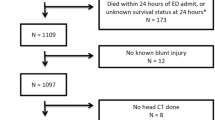Summary
A total number of 58 parameters (laboratory values, neurological symptoms, and vegetative parameters) were evaluated in 150 patients during the first seven days after severe head injury. The patients were divided into two groups, “survivors” and “non-survivors”. Eight easily evaluable routine parameters with the most significant differences between the two groups of patients were used for statistical evaluation of a “no survival chance score”. These highly indicative parameters are serum osmolarity and urea, blood glucose, total bilirubin, motor reaction to stimuli, body temperature, respiratory activity, and pupil reaction. A “low survival chance limit” was evaluated from each of these parameters by computer analysis. None of the patients in the series survived when three or more of these eight parameters had climbed beyond the limit. So far, the system is able to predict “no survival chances” in 50.8% of the non-survivors some six days prior to death; 80% of these predictions could be made by the fourth day after injury.
Similar content being viewed by others
References
Auer, L., Beitrag zur Pathophysiologie des posttraumatischen Hirnödems, Wien. klin. Wschr.87 (1975), 556–560.
Auer, L., Petek, W., Serum-globulin-changes in patients with cranio-cerebral trauma. J. Neurol. Neurosurg. Psychiat.39 (1976), 1076–1080.
Auer, L., Marth, E., Proteolytische Enzymaktivität im Liquor cerebrospinalis nach Schädelhirntrauma. Vorläufige Mitteilung. Acta Neurochir. (Wien)39 (1977), 47–51.
Auer, L., Petek, W., Serum-Alpha-2-Globulin-Veränderung bei Patienten mit Schädelhirntraumen. Acta Chir. Austriaca9 (1977), 116–119.
Auer, L., Tritthart, H., Ekhart, E., Oberbauer, R., Therapeutic consequences of simultanous ICP and blood pressure measurements in patients with severe head injury. Proc. 6th Int. Congr. Neurol. Surg., SÃo Paulo, 1977, p. 115–116.
Auer, L., Gell, G., Tritthart, H., Holzer, H., Azotaemia in severe head injury—central dysregulation or renal failure? Acta Neurochir. (Wien)41 (1978), 355–361.
Auer, L., Petek, W., Serum-haptoglobulin-changes in patients with severe isolated head injury. Acta Neurochir. (Wien)42 (1978), 229–234.
Auer, L., Disturbances of the coagulatory system in patients with severe cerebral trauma. I. Acta Neurochir. (Wien)43 (1978), 51–59.
Auer, L., The pathogenesis of hypertensive encephalopathy. Acta Neurochir. (Wien) suppl.27 (1978), 1–111.
Auer, L., Marth, E., Proteolytic enzyme activity in patients with severe head injury and the effect of a proteinaseinhibitor—a double blind study. Acta Neurochir. (Wien)49 (1979), 207–217.
Auer, L., Ott, E., Disturbances of the coagulatory system in patients with severe head injury. II. Acta Neurochir. (Wien)49 (1979), 219–226.
Auer, L., Long-term-monitoring of ventricular fluid pressure in patients with head injury—problems and indications. Neurosurg. Rev., in press 1979.
Brodersen, P., Jorgensen, E. O., Cerebral blood flow and oxygen uptake and cerebrospinal fluid biochemistry in severe coma. J. Neurol. Neurosurg. Psychiatr.37 (1974), 384–391.
Feldmann, H., Klages, G., Gärtner, F., Scharfenberg, J., The prognostic value of intracranial pressure monitoring after severe head injuries. Acta Neurochir. (Wien) suppl.28 (1979), 74–77.
Frowein, R. A., Prognostic assessment of coma in relation to age. Acta Neurochir. (Wien) suppl.18 (1979), 3–12.
Gaab, M., Trost, H. A., Pflughaupt, K. W., The prognostic value of osmolality within the first week of sustaining head injury. Acta Neurochir. (Wien) suppl.28 (1979), 115–119.
Gobiet, W., Monitoring of intracranial pressure in patients with severe head injury. Neurochirurgia20 (1977), 35–47.
Habbema, J. D. F., Braakman, R., Avezaat, C. J. J., Prognosis of the individual patient with severe head injury. Acta Neurochir. (Wien) suppl.28 (1979), 158–160.
Heller, W., Oldenkott, P., Die Enzymdiagnostik bei traumatisch bedingten Hirn-Erkrankungen. Acta Neurochir. (Wien)20 (1978), 299–308.
Jennett, B., Bond, M., Assessment of outcome after severe brain damage. Lancet1 (1975), 480–492.
Jennett, B., Teasdale, G., Galbraith, S., Pickard, J., Grant, H., Braakman, R., Avezaat, C., Maas, A., Minderhoud, J., Vecht, C. J., Heiden, J., Small, R., Caton, W., Kurze, T., Severe head injuries in three countries. J. Neurol. Neurosurg. Psychiatr.40 (1977), 291–298.
Knoblich, O. E., Gaab, M., Prognostic information from EEG and ICP monitoring after severe closed head injuries in the early post-traumatic phase. Acta Neurochir. (Wien) suppl.28 (1979), 58–62.
Lobato, R. D., Rivas, J. J., Portillo, J. M., Velasco, L., Cordobes, F., Esparza, J., Lamas, E., Prognostic value of the intracranial pressure levels during the acute phase of severe head injuries. Acta Neurochir. (Wien) suppl.28 (1979), 70–73.
Nau, H.-E., Reinhard, V., Bongartz, E. B., Flo\dorf, R., Risk factors in severe head injury. Acta Neurochir. (Wien) suppl.28 (1979), 174–178.
Richard, K. E., Frowein, R. A., Significance of intracranial pressure and neurological deficit as prognostic factors in acute severe brain lesions. Acta Neurochir. (Wien) suppl.28 (1979), 66–69.
Serrats, A. F., Parker, S. A., Head injury prognosis: Calculations from clinical data. Acta Neurochir. (Wien) suppl.28 (1979), 165–170.
Teasdale, G., Jennett, B., Assessment of coma and impaired consciousness. Lancet1 (1974), 81–83.
Teasdale, G., Skene, A., Parker, L., Jennett, B., Age and outcome of severe head injury. Acta Neurochir. (Wien) suppl.28 (1979), 140–143.
Teasdale, G., Parker, L., Murray, G., Knill-Jones, R., Jennett, B., Predicting the outcome of individual patients in the first week after severe head injury. Acta Neurochir. (Wien) suppl.28 (1979), 161–164.
Author information
Authors and Affiliations
Rights and permissions
About this article
Cite this article
Auer, L.M., Gell, G., Richling, B. et al. Predicting lethal outcome after severe head injury — A computer-assisted analysis of neurological symptoms and laboratory values. Acta neurochir 52, 225–238 (1980). https://doi.org/10.1007/BF01402078
Issue Date:
DOI: https://doi.org/10.1007/BF01402078




